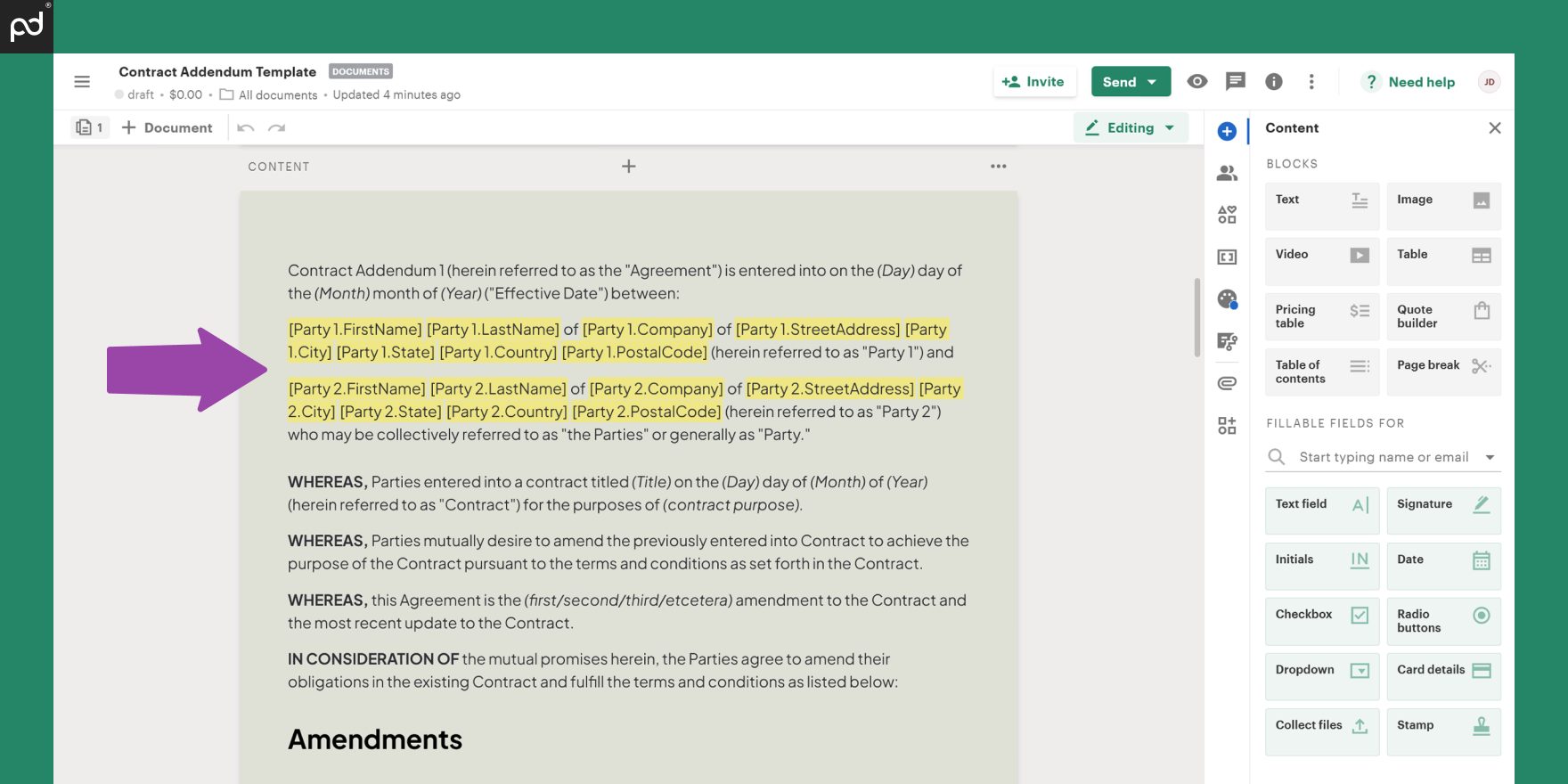Once a contract is signed and sealed, it’s set in stone — or is it?
Things often change, and knowing how to write an addendum to a contract can be a valuable skill in many situations.
Let’s explore what an addendum to a contract is and how you can write one in 7 easy steps.
Key takeaways:
- The goal of an addendum is to modify, clarify, or add new terms or conditions to an existing contract without creating an entirely new agreement.
- The key steps in writing an addendum to a contract are mirroring the language of the original agreement, specifying involved parties, clarifying the part of the contract the addendum refers to, ensuring compliance, and seeking legal advice when required.
- You can streamline and simplify the process of writing an addendum to a contract using sales and document management software.
What is an addendum to a contract?
An addendum to a contract is a legally binding document that is added to an existing legal contract.
Once a contract is signed, it’s usually difficult to change it without invalidating it. An addendum avoids the need to create a whole new contract, allowing parties to introduce new clauses while keeping the original contract intact.
And since it’s legally binding, an addendum can alter any terms and conditions of the original contract.
Contract addendum vs. amendment
Many people confuse the terms contract addendum and contract amendment.
The difference between them lies in how they interact with the original contract:
- A contract amendment changes clauses or sections of an existing contract.
- An addendum is a separate document that extends the terms and conditions of a contract but does not change the existing text.
Both amendments and addendums involve, and therefore must be agreed upon, by all parties to the contract in order to be valid.
1. Mirror the language of the original contract
While an addendum is its own document, its purpose is to update or correct an original contract.
As such, it should mirror that original document as much as possible.
Be sure to continually refer to the contract when drafting an addendum. In particular, consider the contract’s:
- language;
- formatting and layout;
- font and style.
As far as possible, match all of these in the addendum.
That way, no parties should doubt that the addendum is as important — and as relevant — as other clauses of the contract.
2. Choose an addendum title
Your addendum needs to clearly indicate what changes it makes and to which original contract. The first place you can do this is in your addendum title.
Give the addendum a title that references the original agreement’s name and date, and make it clear that it is indeed an addendum to that agreement.
For instance, perhaps you’re drafting an addendum to a residential lease agreement originally signed on the 1st of January 2021. Your addendum title might be:
“Addendum to Residential Lease Agreement Between [Your Name (owner)] and [Lessee’s Name (tenant)] of 1st January 2024.”

Contract Addendum Template
Used 5826 times
Do you need a legal arrangement that modifies a pre-existing warranty between two or more parties? Just use this Contract Addendum Template.
Use this template3. Specify the parties
As the title suggested above shows, it’s crucial to specify the parties — usually mirroring those listed in the original document. This ensures that everyone understands who is party to the addendum.
If a third party has an interest in the contract addendum, make sure to clearly mention their involvement.

4. Clarify the part of the original contract the addendum refers to
Addenda update an existing agreement, so they usually refer to a specific part of the original contract.
You should cite the title of any clause an addendum relates to and use font styles like italics, bold, and strikethrough to make clear what’s being replaced or modified.
For instance, say you are writing an addendum to a car rental lease agreement to change details of the vehicle.
Part of your addendum may look like this:
Original “Identification of Rental Vehicle” element of the Agreement:
Make: Ford
Model: Fiesta
VIN: 12345678
Color: Red
Year: 2020
Modifications proposed by this Addendum:
Make: Ford
Model: Fiesta Focus
VIN: 12345678
Color: Red
Year: 2020
5. Ensure compliance with the original contract and all relevant regulations
To ensure your addendum is fit for purpose and binding, it must not go against the original terms or requirements of the contract itself.
It should also comply with all laws and regulations in your jurisdiction.
It’s vital to check this before asking any parties to agree to the addendum.
6. Add any additional elements
As well as the details sketched out above, most addenda will need to include some other elements:
- The effective date of the addendum;
- Relevant force majeure circumstances if not already covered in the original;
- A signature block to sign and date the addendum — either physically or with an eSignature;
- Disclaimers or other similar clauses, if required.
7. Consider seeking legal advice
Finally, it’s worth considering seeking the advice of a law firm or legal professional before you present the addendum to the relevant parties.
This could help you keep the addendum from falling foul of laws or regulations — even those you may not be aware of.
Addendum to contract sample scenarios
An addendum to a contract can be used in various scenarios. Let’s explore some.
1. Addendum to an employment contract
Employment agreements can be lengthy documents, and it can often be the case that some clauses and details are left out either intentionally or unintentionally.
An addendum to an employment contract offers an opportunity to remedy such omissions or to add new details to remedy clauses in the original contract that may have been contentious.
A good example of a case when an addendum to an employment contract is needed is when the original contract’s clause regarding termination of employment only included death or employee resignation.
An addendum could be added later that also includes other grounds for termination, such as gross misconduct, breach of contract by the employee, or scenarios where the company is suffering financially and has to make compulsory redundancies.
2. Addendum to alter insurance coverage
Another type of contract that often needs addendums is a contract for insurance coverage.
There are many scenarios in which an addendum to an insurance contract may be required; for example, state laws regarding insurance sometimes undergo changes.
As well as factors directly related to insurance, there’s also the aspect of data protection.
An addendum may be needed to reflect changes to the regulatory framework and compliance requirements surrounding how a company handles a customer’s confidential information.
3. Addendum for real estate purchase contracts
The real estate sector is one where there’s a frequent need for addendums to original contracts.
There are multiple scenarios where the details in the first signed agreement change and an addendum is needed to update them and keep the contract legally binding.
Some of those scenarios include:
Extension of the closing date
If problems arise, such as with the buyer’s financing or with the sale of the buyer’s own property, the buyer and seller can agree to an extension.
Escrow holdback
An agreement may be put in place so that full payment can be withheld until certain tasks are carried out by the seller.
Inspection contingency
The buyer may choose to add an inspection contingency addendum so that if any inspection reveals issues with the property, they can withdraw from the sale or request that the issues be resolved.
Seller financing
In some cases, such as with developers, the seller may agree to grant the buyer a mortgage.
A contract addendum could include all details of such financing, such as the repayment period and monthly payments.
Short sale
If the seller of a property owes more money on it than the current market value, this addendum directs the seller to field offers on the property but also to seek their creditor’s consent to accept an offer.
Purchase-agreement termination
This addendum type may be needed when there’s a mutual agreement to cancel the sales contract and recognizes that neither party holds the other at fault.
It may also cover details regarding the return of a deposit and when that return should take place.
Write an addendum to a contract with a user-friendly PandaDoc template
Writing an addendum can sound like a complicated process, but it doesn’t have to be.
And while you may want to use an attorney for more complicated addendums, in most cases, creating an addendum is an exercise you can carry out yourself as long as you’re aware of what an addendum to a contract should look like.
What can make the process even easier is using a contract addendum template from PandaDoc. It can be used in any scenario where one or more parties want to change certain details of the original contract.
A great benefit of using one of our templates is that it takes care of all the tricky legalese that is needed in such documents and allows you to focus on the details you need to change or rectify.
While a template removes the need for legal expertise, you may still have to double-check some details, such as compliance with relevant laws.
By following the guidelines above and ensuring that all changes have been agreed upon, you’ll find that what could be a complicated process is extremely simple, and can be accomplished without an in-depth knowledge of contract law. Whether adding an addendum to an employment contract or adding new terms agreed upon with a client, PandaDoc makes it as easy as A, B, C.
Disclaimer
PandaDoc is not a law firm, or a substitute for an attorney or law firm. This page is not intended to and does not provide legal advice. Should you have legal questions on the validity of e-signatures or digital signatures and the enforceability thereof, please consult with an attorney or law firm. Use of PandaDoc services are governed by our Terms of Use and Privacy Policy.
Originally published January 10, 2023, updated August 5, 2024


